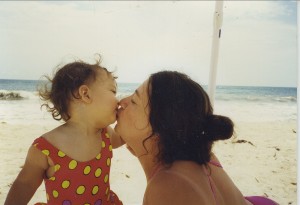
Hannah and Me.
As Thanksgiving approaches, some of us embrace the holiday with happiness and anticipation. Others have sadness and trepidation. I fall somewhere in the middle. My daughter’s twin brother Timothy, died in utero at seven months during Thanksgiving holiday, November 1993. Until then my two babies were dancing and playing in my belly as seen on the ultrasounds, while the doctors carefully monitored their development. Both babies were growing, but Timothy’s smaller size concerned the doctors. My daughter Hannah had always faced her “little twin brother,” but as soon as he died she instinctually turned away. When Timothy died, I was simultaneously a womb and a tomb for two months. Hannah kept growing bigger and stronger, and Timothy was shrinking. I delivered my daughter Hannah and my deceased son, Timothy, who looked like roadkill by the time the doctor pulled him out of my belly, on February 1, 1993.
I was full of happiness and gratitude for giving birth to a healthy little girl – a baby I worked many years to finally conceive and deliver. Yet, in that blissful state, I also sat in a dark cave of sadness. Can these emotions coexist? Yes, for me, they can and often do during Thanksgiving. That’s one reason the Thanksgiving holiday can produce angst and confusion along with joy. It is an emotional quagmire despite the celebratory atmosphere, and particularly confusing to young adults who, themselves, may experience unfamiliar conflicting emotions.
To truly embrace gratitude during Thanksgiving, it is important to quietly sit and reflect on what gratitude really means before the holiday commences. How do you embrace gratitude when confronted with the duality of life? What does birth and death, health and sickness, good and bad, ignorance and enlightenment, prejudice and acceptance, success and failure and abundance and scarcity mean to you? How do you navigate through the ups and downs of life so it doesn’t feel like a nauseating rollercoaster ride?
Life is getting more intense by the day. Younger people could truly benefit from guidance on how to embrace gratitude without just giving it lip service around the dining room table during Thanksgiving dinner. What tools related to “giving” and “thanks,” has helped you to tap into to become spiritually more vibrant and emotionally resilient? How do you weather life’s highs and lows? What does gratitude really mean in your life?
Then, write these thoughts down into a legacy letter and give it to a younger person before or during the holiday. Perhaps include stories of past Thanksgivings and read the letter orally, and provide an opportunity for reflection and discussion among family and friends before or after Thanksgiving dinner. Or just sit quietly with one loved one who could most benefit from a gentle discussion about overcoming life’s challenges while cultivating gratitude. Some say that gratitude is one of the sweet shortcuts to finding peace of mind and happiness, and feeling gratitude and not expressing it is like wrapping a present and not giving it. So express that gratitude by writing a legacy letter about gratitude – a true gift! Or you can tap into gratitude the old fashion Jewish way, “Remember: it could always get worse.”
Leah Dobkin